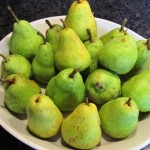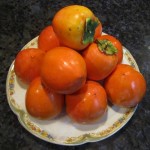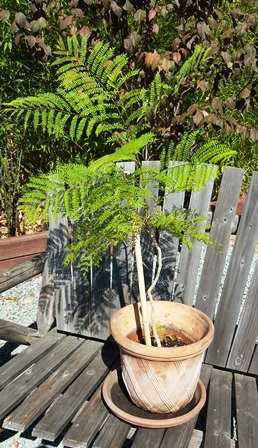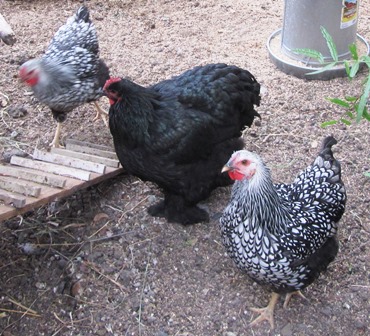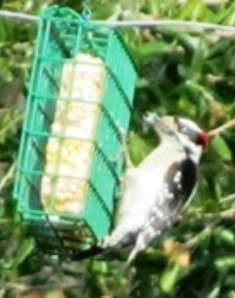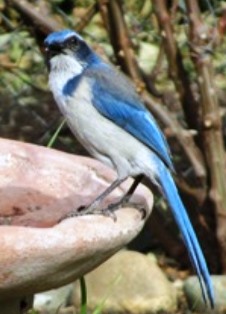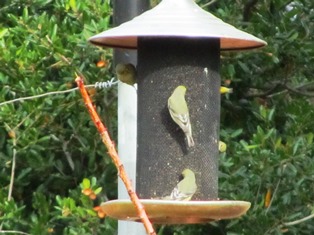The Fall “P” Fruits Are Ripening on the Farmette
Our pears, persimmons, and pomegranates hang heavy on the trees now. This despite the scorching summer we’ve had and the lack of rain. Water restrictions have made it doubly difficult for the fruits of these trees to reach their full potential.
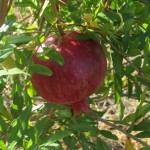
Ripe pomegranates have a leathery outer skin, membranes thicker than oranges, but sweet, juicy seeds inside
The squirrels and raccoons have been munching on the late summer pears. Yesterday, I stripped most of the fruit off and placed in paper bags in the kitchen cabinet. In two to three days, the pears will reach the perfect ripeness for eating fresh.
Fuju and hachiya persimmons are taking on color and should be ripe and ready to eat in about a month. I’ve been working hard to save the trees that are suffering from California’s extreme drought.
A spokesman for one Bay Area water resource board suggested we gardeners let our ornamental plants like roses and other flowers go while we try to save our trees. A hard thing for me to do. Praying for rain, we hold out hope that next year’s climate will be better for backyard gardeners and growers.
______________________________________________________________________________
Interested in backyard gardening topics like keeping chickens and bees or growing heirloom vegetables? Check out my cozy mystery series from Kensington. The stories are informed by my work on the farmette I’ve been restoring for a dozen years. Find all Meera Lester books on Amazon.com, Barnesandnoble.com, and everywhere books are sold online or in brick and mortar stores.
Beeline to Murder features a former cop who keeps bees
and sells lavender honey to her town’s celebrity chef . . . until
she finds him dead.

The town of Las Flores is abuzz with the news of the death of a free spirit who has secrets in her background and ties to a local nudist camp.

The renewal of wedding vows ends on the steps of the church with the outburst of a local woman intent on revenge. The husband is soon found dead but the obvious suspect may not be the culprit at all.
Plant Dahlias and Canna Lilies Now for Dazzling Summer Color
Love the tropical foliage and brilliant color of dahlia and Canna lily blooms? Plant them now through April if you live in Zones 8 through 11. Long prized as cut flowers for bouquets, dahlias and Canna lilies do not fail to dazzle also when grouped in flowerbeds alone or with other summer blooming plants.
Indigenous to Central Mexico, dahlias are herbaceous, leafy plants that offer blooms in a wide assortment of colors (except blue and black). Bloom size ranges from a couple of inches across to roughly a foot wide (the largest size is known as “dinner-plate”). Tall varieties need staking and all types can benefit from dead-heading when blooms are spent.
Dahlia roots are actually tubers and do best when planted in moist, well-drained, loamy soil. If growing them in areas where there is frost, dig and store the tubers in a cool, dry (and frost-free) place in the fall for re-planting the next year. In extreme climates like the high desert, dahlias benefit from several inches of mulch covering the bed.
The main pests of dahlias are slugs, snails, earwigs, leaf hoppers, and aphids. Powdery mildew and gray mold can also infect the plant.
Canna lilies, like dahlias, are herbaceous summer-blooming plants that come in a wide variety of colors. Indigenous to sub-tropical areas of North and South America, Cannas can be grown as perennials in zones 7 through 11, according to the U.S. Department of Agriculture. In other zones with more extreme climates, mulch the plants two to four inches deep or lift the rhizomes (roots) and store them in dry peat moss in a cool, dry place until ready to replant.
Plant rhizomes of tall Canna lilies at the back of the flowerbed (or at the front of the bed if the plants are dwarf) in three to six inches of rich, well-drained soil. Position so that the eyes are facing up. Pests include slugs, snails, Canna leaf-rollers, and Japanese beetles. Aphids can spread canna viruses that can cause leaf streaking and bloom disfigurement. The plants are heavy feeders so will need a good organic fertilizer when they begin to look ratty and two to four inches of water each week.
Use tall dahlias and Canna lilies at the back of your flowerbed and add mid-size blooming plants in the middle and dwarf or low growing bedding plants with lots of color at the front to create a spectacular garden area this summer. If you live in a relatively frost-free zone, your dahlias and Canna lilies will spring back to life and carry on with colorful displays amid tropical foliage for years to come.
__________________________________________________________________________________
If you enjoy reading about gardening and the natural world, check out my series of cozy mysteries that include information on growing heirloom plants and keeping chickens and bees. Also see my self-help empowerment and well-being books. All are available online and in bookstores everywhere.

The Henny Penny Farmette series of cozy mysteries–lots of delicious recipes and information for country living
CLICK ON THE LINK to see more.
A Forty-foot Tall Brazilian Beauty
We recently lost the elm tree that stood about 25 feet tall next to the small house on our Henny Penny Farmette. On hot days, we really feel the heat now that the elm’s shady canopy is gone. Among the trees we are considering as a replacement for the elm is a Jacaranda mimosaefolia.
This Brazilian beauty will grow to 40 feet tall and spread from 15 to 30 feet wide. The trees begin to branch profusely when they reach about 6 feet high. I love the fernlike leaves and the 8-inch long clusters of bluish-lavender tubular flowers. The tree blooms abundantly in June and is stunning in any landscape or garden.
The trees will tolerate a wide variety of soil types. Water must be consistent but too much will create profuse tender growth and too little will stunt the tree. We purchased two of these gorgeous trees and will plant them at the front of our home, far enough away from each other to allow them to mature without crowding.
Although I will miss the elm shade until the jacarandas grow large, I won’t miss the debris of seed pods and small branches easily fractured from the elm. Mature Jacaranda’s in full bloom are a sight to behold and they’re fairly easy to grow.
* * *
If you enjoy reading about farmette topics (including gardening, beekeeping, and delicious recipes), check out my cozy mysteries A BEELINE TO MURDER and also THE MURDER OF A QUEEN BEE in the Henny Penny Farmette series (from Kensington Publishing).
Enter the Goodreads Giveaway–September 29 to October 6–for a chance to win a signed copy of a first-edition hardcover of The Murder of a Queen Bee. Three lucky winners will be chosen.
These novels are chocked full of recipes, farming tips, and sayings as well as a charming cozy mystery.
The books are available through online retailers such as Amazon, Barnes & Noble, Kobo Books, and Walmart as well as from traditional bookstores everywhere.
See, http://tinyurl.com/hxy3s8q
This debut novel launched the Henny Penny Farmette series of mysteries and sold out its first press run. It’s now available in mass market paperback and other formats.
See, http://tinyurl.com/h4kou4g
Release date is THIS WEEK–September 27. This book, the second cozy mystery in the Henny Penny Farmette series, is garnering great reviews on Goodreads.com.
It’s available free on Net Galley (netgalley.com) for readers, bloggers, and other professionals who write reviews.
Chicken Bad Behavior–Best Nipped in the Bud
Many factors can affect the health and egg laying of your chicken flock, including weather, housing, size of population, breed, molting, parasite load, and nutrition. But when chickens start viciously pecking other hens or eating eggs, the underlying issues must be addressed.
Most often, the issue is a case of stress. Causes of chicken stress include overcrowding, excessive heat, too much bright light, lack of food and/or fresh water, and bad diet.
Other factors can include disruption of the pecking order by introducing new birds, especially those of other breeds (for example, fowl with combs and those without) or mixing old fowl with young. These factors all relate to flock management.
When birds start eating eggs (usually finding a cracked egg or broken ones, tasting them, and then pecking eggs to break them to eat) or viciously pecking on other hens, it’s best to figure out what in the hens’ environment is causing the stress. The causes must be eliminated.
For more tips on farming and beekeeping, plus delicious recipes, check out my newest mystery–A BEELINE TO MURDER. See, http://tinyurl.com/p8d6owd
Little Foxes on my Front Porch
The heat drove me from bed this morning around 6 a.m. Northern California is in the midst of a triple-digit heat wave and there’s not much relief at night.
I made coffee, as I always do as soon after rising, and peeked out the back sliding glass door. I can see into the chicken house because my husband installed windows. The chickens were still on the roost. I’d have time for a swallow or two of coffee.
Then I heard what sounded like a knock at the front door. Padding across the living room in bare feet, I opened it, half expecting to see my daughter (also an early riser; she likes making runs to Starbucks for her coffee).
It wasn’t my daughter. It was a small fox. The poor thing seemed as startled to see me as I was to see it.
When the fox bounded off the porch, I saw the other two. Yes, there were three–a whole family–in my front yard. Perhaps they came down from the hills of Mount Diablo to search for water or food . . . so back to the chickens I went.
Certain that there was no way for the foxes to get into the chicken run, I let the hens out; gave them food and water. Then, after searching the property for those little foxes, I went back to enjoy my coffee while the sun rose to begin roasting the Bay Area.
Yellow-Rumped Warbler and Other Songbirds Act Like It’s Spring
It’s the middle of January but tell that to Mother Nature whose songbirds are singing like it is spring. With our temperatures expected to exceed 70 degrees Fahrenheit in parts of the Bay Area today, the birds are gathering around feeders and fountains and the bees are buzzing about, too.
While having coffee on the patio this morning, I had the privilege of being visited by a variety of winged friends, some seemingly oblivious to me and my camera.
The woodpecker announces himself with the familiar rat-ta-tat-tat while the yellow-rumped warbler and other songbirds hang out in the firethorn bush, in the oak trees, and at several fountains we’ve placed at the rear of our farmette.
There’s a lot of bee traffic today. With warm days forecast for the next week or two, the bees could get the wrong idea and swarm. That would undoubtedly surprise the local backyard bee hobbyists.
So while I love the warm weather–especially when I read about the polar temperatures causing such misery in the Midwest and along the East Coast–like many Californians, I am beginning to worry about the looming possibility of a drought this year and mandatory water rationing.
But, then again, there’s something magical about hearing songbirds trilling in the dead of winter when the fruit trees in the orchard and the roses lining the path to the front door remain soundly asleep. I think I’ll have another cup of coffee and sit for a while longer.
 Facebook
Facebook Goodreads
Goodreads LinkedIn
LinkedIn Meera Lester
Meera Lester Twitter
Twitter




